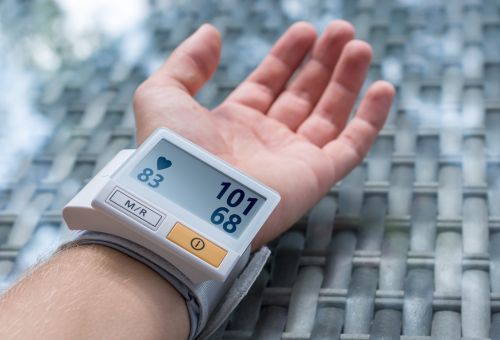Hypertension, or high blood pressure, is an increasingly prevalent health issue that affects millions of people worldwide. The power of technology is being used to manage and prevent this condition, with wearable devices playing a vital role. This article will explore how wearable devices can help lower blood pressure.
We also answer smart heart blood pressure monitor related questions, including:
- Does health insurance cover blood pressure monitor?
- How to calibrate electronic blood pressure monitor?
- Wrist blood pressure monitor or upper arm: Which one is better?
Let’s start!
Importance of Monitoring Blood Pressure
Uncontrolled hypertension can have serious health complications, including heart disease, stroke, and kidney failure. Therefore, it is crucial to monitor blood pressure regularly for early detection and management.
- Keeping a Pulse on Health
Regular blood pressure monitoring is essential, as it allows individuals and healthcare professionals to track changes and implement necessary interventions to maintain optimal blood pressure levels.
- Ease of Use
As the prevalence of hypertension continues to rise, wearable devices for blood pressure monitoring have emerged as a game-changer in tracking and managing this health concern. These innovative gadgets, ranging from smartwatches to fitness trackers, seamlessly integrate blood pressure monitoring into our daily lives, offering a convenient and non-invasive approach to keeping an eye on this vital health metric.
- Continuous Monitoring
Wearable devices (i.e., smartwatches and fitness trackers) have become popular tools for tracking various health metrics, including blood pressure. These devices offer a convenient way to monitor blood pressure levels continuously and unobtrusively.
- Advanced Features of Blood Pressure Wearables
These devices often come with features like accuracy, ease of use, and connectivity with smartphones, making them an attractive option for users seeking to monitor their blood pressure.
How Can Wearable Devices Help Lower Blood Pressure?
- Stress Reduction and Mindfulness
Stress is a significant contributor to high blood pressure, and wearable devices can help monitor and reduce stress levels. Many devices offer features like heart rate variability tracking and guided breathing exercises, promoting relaxation and stress reduction. Additionally, some devices come with mindfulness apps that encourage users to engage in meditation and other stress-relieving practices.
- Physical Activity and Fitness Tracking
Regular physical activity is crucial for maintaining healthy blood pressure levels. Wearable devices can track various exercise metrics, including steps, calories burned, and heart rate, motivating users to stay active. By setting fitness goals and tracking progress, these devices can help users develop an exercise routine that effectively lowers blood pressure.
- Sleep Monitoring
Sleep quality is closely linked to blood pressure, with poor sleep contributing to increased blood pressure levels. Wearable devices can monitor sleep patterns, providing insights into sleep quality and duration. By identifying sleep disturbances and providing recommendations for improvement, these devices can help users maintain healthy blood pressure levels through better sleep.
- Personalized Health Insights
Wearable devices collect a wealth of data on an individual’s health metrics, enabling the generation of personalized health insights and recommendations. These insights can help users identify specific lifestyle changes that may positively impact their blood pressure levels. For example, a device may suggest adjustments in diet, exercise routines, or stress management techniques based on the user’s unique data. By implementing these personalized recommendations, users can work towards lowering their blood pressure effectively.
Does Health Insurance Cover Blood Pressure Monitor?
The potential for health insurance coverage for blood pressure monitoring devices varies depending on the insurance plan and provider. It is possible for some plans to cover the cost of a wearable blood pressure monitor if deemed medically necessary, while others may not. It is essential to consult your insurance provider to understand your coverage and any limitations.
How to Calibrate Electronic Blood Pressure Monitor?
Calibration is essential for ensuring the accuracy of electronic blood pressure monitors. To calibrate your device, follow these steps:
- Consult your device’s user manual for specific calibration instructions.
- Place the monitor on a flat, stable surface and ensure it is at the same level as your heart.
- Connect the device to the appropriate calibration equipment, as specified in the user manual.
- Follow the on-screen prompts or “user manual” instructions to initiate the calibration process.
- After calibration, verify the device’s accuracy by comparing its readings with those of a standard blood pressure cuff.
Smart Heart Blood Pressure Monitor
Smart heart blood pressure monitors are wearable devices specifically designed to track blood pressure alongside other health metrics. These devices offer advanced features, such as automatic inflation, irregular heartbeat detection, and data syncing with smartphones, allowing for a comprehensive view of your heart health.
Wrist Blood Pressure Monitor or Upper Arm: Choosing the Right Device for You
Wrist blood pressure monitors and upper arm blood pressure monitors are two popular choices for measuring blood pressure at home. Wrist monitors offer convenience and portability, allowing users to easily measure their blood pressure on the go.
However, they may be more sensitive to positioning and movement, potentially leading to less accurate readings.
On the other hand, upper arm blood pressure monitors provide more consistent and accurate results due to their placement over the brachial artery. Though they may be bulkier and less convenient to transport, their reliability makes them the preferred choice for many healthcare professionals and individuals monitoring their blood pressure regularly.
Limitations and Considerations
Despite the numerous benefits of wearable devices in blood pressure management, there are some limitations to consider. For instance, some devices may not be as accurate as traditional blood pressure cuffs, and users should be cautious about relying solely on wearable devices for blood pressure monitoring.
It is essential to remember that wearable devices should not replace professional medical advice. Consulting healthcare professionals for proper blood pressure management and personalized recommendations remains vital for maintaining optimal health.
Final Thoughts
Wearable devices offer a convenient and powerful way to monitor and manage blood pressure levels. By addressing factors such as health insurance coverage, calibration, and smart heart monitoring features, users can maximize the potential benefits of these devices. However, it is crucial to remember that wearable devices should be used in conjunction with professional medical advice to ensure the most effective blood pressure management. By harnessing the power of technology, individuals can take control of their health and work towards lowering their blood pressure levels for a healthier future.










